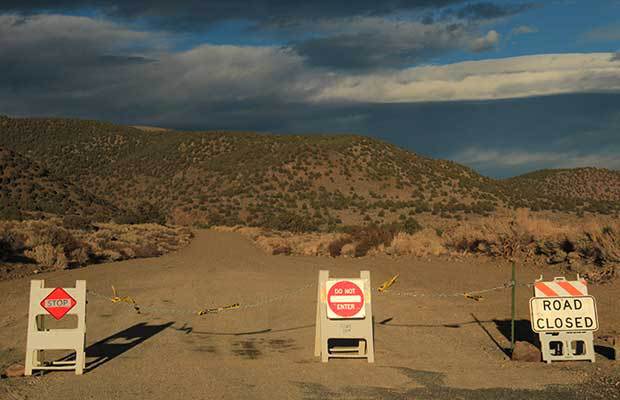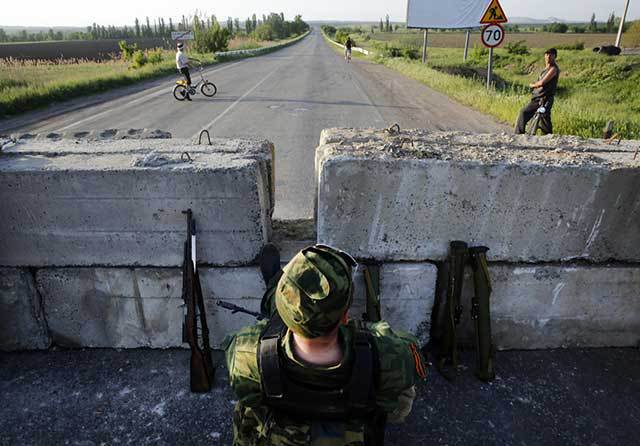
Many preppers have formed a mental picture of the ideal bug out destination being a cabin located in some remote wilderness, well away from any population center. Others imagine an underground bunker where a mutual assistance group (“MAG”) can hunker down and ride things out for as long as is necessary. While these images have their appeal, they also present serious challenges of their own.
In the process of authoring “When There is No FEMA” I had the opportunity to give quite a bit of consideration to the ideal bug out destination, and one question persistently nagged at me – if a survival group is defending a small property in a remote location, then what is to stop a concealed enemy with a high-powered rifle from picking off members of the community one-by-one? For me this highlights a fatal flaw in the “remote cabin” scenario, and underscores an important principle that should apply to any bug out location … any survival group should control a sufficiently large area that their base of operations is outside of rifle range of the perimeter they control.
This principle suggests that a small group is not necessarily the best group for a survival scenario. A small town, by comparison, has the physical size and raw manpower necessary to control a larger geographic area on a 24×7 basis. Additionally, a small town often has infrastructure such as machine shops, heavy equipment and agricultural land that can allow a local economy to be rebuilt.
Of course no scenario is perfect, and the small-town-as-bugout-destination scenario presents its own set of challenges, perhaps the largest of which is that only a small percentage of the population will be even remotely prepared in advance. While my book has the pages to go into great detail on how to quickly adapt a small community in the wake of social collapse, this article can at least provide an overview of the important topic.
Because great majority of an area’s inhabitants are going to be unprepared every second that passes will be critical. In the immediate aftermath there will be a lot of nervous energy, and this will be the absolute worst time for the clear thinking needed to define a viable survival community. However, that nervous energy could be constructively channeled into executing a plan that has already been developed. This article will cover the basics of such a plan (with this stipulation that there are always 1000 ways to skin the proverbial cat).

Physical security should be one of the first priorities.
All small communities are not created equal. While an urban neighborhood or small suburb may provide the manpower and geographic size to meet post-disaster survival needs, unlike small towns they often do not have the agricultural or industrial base needed to support an independent economy. Additionally, inhabitants in these more urban locations are much less likely to possess the survival skills their rural counterparts take for granted.
There are some critical prerequisites to successfully adapting a small, unprepared community to survive a major disaster. They include:
- Mitigation of all immediate threats to life and property
- Producing a community charter that will govern the community.
Mitigation of immediate threats includes such basic activities as putting out fires, tending to the injured and placing sandbags to prevent property from flooding.
The community charter is a document that identifies elected offices and the terms of such offices, sets forth the procedures for electing officers, and defines their responsibilities. It should also specify those within the community who are eligible to vote and the procedures for carrying out elections (in recognition of the crucial factor of time the charter might describe the use of a fair coin toss to decide the outcome of tied elections, rather than requiring time-sensitive runoff elections). The charter should also specify if capital and corporal punishments are to be considered for some offenses and have provisions for such things as amending the charter and the recall of elected leaders.
NOTE: Chapter 14 of “When There is No FEMA” provides a complete, detailed community charter.
The charter should also cover:
- Printing and minting of new coins and currency for the community
- Identifying the initial elected and appointed leadership positions within the community and specifying their wages (in the community’s currency)
- Processes for bringing outsiders into the community
- Ownership of property
- Crime and punishment – specifically identifying those crimes for which capital punishment, corporal punishment, or banishment from the community may apply
- A minimum wage for those working within the community (this critical factor will be discussed in more detail below)
- Defining guidelines for assessing the value of all physical property within the community
- Specifying the oaths of office to be taken by all elected and appointed leaders
If the community votes in favor of capital punishment for select crimes It is a good idea to consider counterfeiting as one of the crimes that are candidates for that ultimate punishment. The corrupting of the community’s monetary system is a direct threat to the lives of all members of the community; thus counterfeiting can reasonably be equated to attempted murder.
Those leaders who are best-suited to lead during non-disaster times are not necessarily the best post-disaster leaders. As a result it would be optimal for new elections to be held to allow those leaders to be installed who are best suited to the new circumstances (NOTE: While new members of the community may move into leadership positions, for obvious reasons those who have best knowledge of critical infrastructure such as water and sewage systems should almost certainly be retained in those typically appointed positions.) In my book I describe the election of a Council consisting of an odd number of members of the community. The odd number is to avoid the possibility of tie votes. Once elected, those council members might vote for who among them will be the council leader. In addition to normal council responsibilities, the Council leader is responsible for scheduling and organizing Council meetings and setting meeting agendas.
Once elected, the council members should appoint various others to leadership positions specified in the charter, and assign those appointees the tasks of developing plans for organizing those areas of the community that are within the scope of their responsibilities (any such tasks must have aggressive deadlines assigned). Appointed positions might include a head of defense, a chief of police, a director of public works, the community banker, a property assessor and directors of health, education, agriculture and finance.
Jump-Starting the Local Economy
As the post-disaster clock ticks, growing seasons for crops come and go, and the members within the community grow more hungry and desperate. Hence it is vital that the local economy be restarted immediately. In the aftermath of a major disaster anyone who does not make this their primary focus is courting misery and death. One of the most important roles in restoring the economy is that of the newly appointed community banker, and the banker’s first job should be to identify a means for the printing of money and the minting of coins.
NOTE: Depending on the nature of the disaster, the role of banker may be one that is not particularly popular. However, the post-disaster community banker is an entirely different beast than any international bankers who may be considered to have brought about a financial collapse. The role of community banker is critical to the survival of the community in the aftermath of a major disaster.

A currency replacement will need to be created.
The polish and appearance of the community’s new currency is not particularly important because it can be upgraded at any time (all the banker has to do is to announce that the old currency will become worthless at some specified date, and invite community members to trade that soon-to-be-worthless currency for any superior version of the currency that is developed). The total amount of currency produced should be a fixed value, with all future printed currency either being produced in accordance with a pre-existing plan or as part of a program to replace and retire old, worn currency.
As new currency is produced a quantity of the newly-minted money should be distributed to each member of the community based on their age (and possibly other criteria). This will allow members of the community to immediately begin to make purchases, thereby restarting the economy. A substantial amount of the printed money should also be retained by the new government for purposes of paying wages, purchasing services from other members of the community, or to stimulate certain strategic sectors of the economy. Needless to say, the amount of money printed and minted for the community will be substantial – probably the equivalent of many tens of millions of pre-disaster US dollars in the case of a small town. At the same time, 80%-90% of that money should be held in reserve and dispersed into the community over a period of 5-10 years. It is not even necessary for that reserve money to be printed or minted until there is a need to disperse it; it can simply be kept “on the books”.
A minimum wage is yet another of those factors that are fundamental and critical to the community’s survival. While most communities are not sitting atop piles of precious metals that can be used as the basis of assigning value to its money, the setting of a minimum wage has precisely that effect. Rather than setting a single minimum wage, however, tiers of minimum wage might be set based on the age of the worker. This has the effect of helping younger workers to gravitate into the economy (by creating demand for their less-skilled labor) while at the same time providing a healthy incentive for older workers to nurture their own careers before they can be displaced by younger, lower cost workers.
Another important appointed position within the community is that of the property assessor, who is tasked with the responsibility of assigning value to all physical property within the community. Depending on the size and composition of the community, the assessor may have a need for a staff to work under his or her direction to meet the needs of this position. Using guidelines provided by the charter, the assessor should be able to appraise the value of virtually any physical property for purposes of taxation and/or purchase.
Property Ownership
Ownership of property is another critical linchpin to the stability of the post-disaster community. If property rights are not clearly defined then members of the community will have no faith in the system and will have far less motivation to work. The community charter should take into account the cases of those who owned property within the community pre-disaster, those who have been renting property from current community members, those who have been renting property from outsiders and property within the community that is owned by outsiders. It may be desirable for the community itself to assume ownership of all property owned by outsiders that lies within its physical boundaries. It would be better for such assets to be contributing to the local economy than for them to deteriorate while waiting for an owner who never appears (and if they do eventually appear then accommodations might be negotiated at that time).
Initial Task Assignments
During each public council meeting new tasks should be assigned to elected and appointed officials and the results of already-completed tasks should be discussed. Initially these tasks may take the form of assignments to develop plans. For example, the head of defense may be tasked with developing a plan for the defense of the community. The director of agriculture may be assigned a task to develop plans for foraging and growing the next season’s crops. These plans can then be reviewed, revised and approved, and would result in work assignments for members of the community (or for companies that exist within the community).
Crime and Punishment
In a post-disaster scenario perspectives on capital and corporal punishment may very well change. For example, given the expected scarcity of the basics for human life, the crime of looting might be equated with attempted murder, which the community may decide warrants capital punishment. Also, because the community may not be able to afford to incarcerate a convicted criminal who could otherwise be working constructively, it may be necessary to carry out corporal punishment for certain offenses (in reality corporal punishment may be more humane than incarceration – would you rather suffer through several lashes from a whip or to be separated from your loved ones for months or years?) Additionally, some crimes may simply merit banishment from the community and forfeiture of assets.
Integrating Newcomers into the Community
It is inevitable that outsiders will eventually wish to become part of a successful community. Any such petition should be considered from multiple perspectives. Does the newcomer have a special skill or knowledge that could benefit the community? Is the community in need of physical labor which the newcomer is capable of performing? Is some member of the community willing to speak in favor of the newcomer or to otherwise sponsor the newcomer into the community? Ultimately the decision to accept the newcomer into the community should rest with the Council or those it appoints for this purpose.
Merging with Other Communities
Historically the merging of small communities under difficult circumstances has been a very bloody affair. Often the reluctance of two communities to merge simply reflects the resistance of the community’s leadership to loss of authority. The community charter should outline a means through which two communities could merge while avoiding wasteful conflict. One approach might be to make all decisions regarding potential community mergers through majority vote. Another approach might be to provide a “golden parachute” (e.g. highly desirable employment) to any displaced elected community members in the event that their position is eliminated due to such a merger.
Conclusion
I will paraphrase the American inventor Thomas Edison and say that, while it is essential for a community to adapt itself in the wake of a major disaster, and that adaptation does require establishing leadership and developing plans, the ultimate survival of that community will consist of one percent inspiration (electing officials and planning) and ninety-nine percent perspiration (carrying out those plans). Deadlines assigned for planning should be aggressive, and work under those plans should commence immediately and have its own tight deadlines.
As most members of the community have not prepared themselves prior to the disaster they should work as though their lives hang in the balance – because that is exactly the case!




















